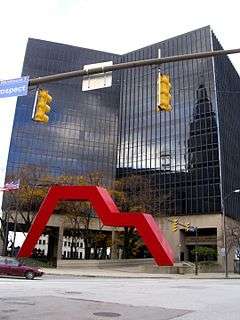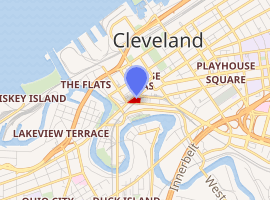Frank J. Lausche State Office Building
The Frank J. Lausche State Office Building is a 1979-erected 204 foot 15 story high-rise in downtown Cleveland on the corner of West Superior and Prospect Avenue on the city's Tower City Center complex.[1] It sits in front of the 2002-built Carl B. Stokes United States Courthouse. The buildings majority of tenants (over 1300) work for the State of Ohio. The structure cost the state $26 million to build in 1977-1979. [2] That would be about $83.5 million in today's inflation rate.[3] In front of the building sits sculptor Tony Smith's Last which serves as a testament to both the city of Cleveland and the state of Ohio's dedication to public art.
| Frank J. Lausche State Office Building | |
|---|---|
 The Last by Tony Smith in front of the Lausche | |

| |
| Former names | Lausche Building |
| General information | |
| Type | Governmental |
| Location | 615 West Superior Avenue Cleveland, Ohio 44113 United States |
| Construction started | 1977 |
| Completed | 1979 |
| Height | |
| Roof | 62.17 m (204 ft) |
| Technical details | |
| Floor count | 15 |
| Floor area | 458,000 sq. ft. |
| Design and construction | |
| Architect | Toguchi Madison |
The uniquely shaped structure is actually seven-sided, which closely resembles the dimensions of the land it is built on as no more land was allotted to the project due to the fact that the Greater Cleveland Regional Transit Authority owned the air rights.[4] The building was erected by the firm of Robert P. Madison of Madison Madison International, a famous Cleveland architectural firm.
Name
The Lausche is named after Frank Lausche, the 47th mayor of the city of Cleveland, who served from 1942 to 1945 [5] He then became the 57th governor of the state of Ohio and served in that capacity from 1945 to 1947 and 1949 to 1957, having lost in between the 1947-1949 term.[6] Following this he served as a United States senator from 1957 to 1969.[7]
References
- http://www.emporis.com/buildings/146862/lausche-state-office-building-cleveland-oh-usa Lausche State Office Building Retrieved on 2015-09-12
- http://das.ohio.gov/Divisions/GeneralServices/PropertiesandFacilities/Lausche.aspx Lausche Building Retrieved on 2015-09-12
- http://www.westegg.com/inflation/infl.cgi The inflation calculator Retrieved on 2015-09-12
- http://www.rpmadison.com/id48__frank_lausche_state_office_building.htm Archived 2011-02-19 at the Wayback Machine Frank J. Lausche State Office Building Cleveland, Ohio Retrieved on 2015-09-12
- http://www.city.cleveland.oh.us/CityofCleveland/Home/Government/MayorsOffice/PastMayors Former Cleveland Mayors Retrieved on 2015-09-12
- http://www.nga.org/cms/home/governors/past-governors-bios/page_ohio.default.html?begin25341aeb-2c72-425f-902c-d68a3c60362c=50&end25341aeb-2c72-425f-902c-d68a3c60362c=74&pagesize25341aeb-2c72-425f-902c-d68a3c60362c=25& Ohio:Past governors" Retrieved on 2015-09-12
- http://ballotpedia.org/List_of_United_States_Senators_from_Ohio List of United States Senators from Ohio Retrieved on 2015-09-12